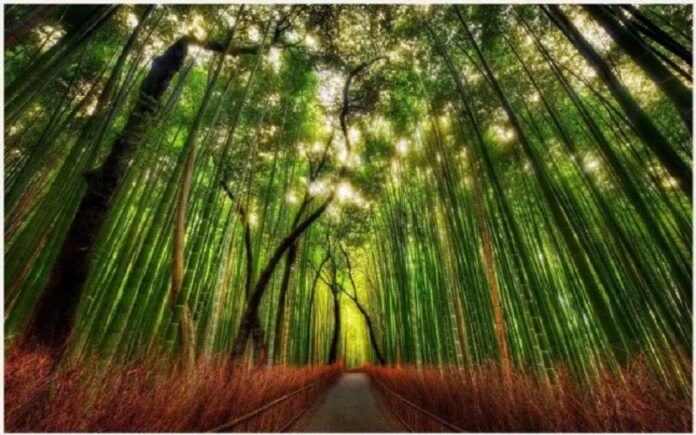Ban on plastic: can bamboo be a substitute? The single-use plastic ban is a concern for many of us. Many of these bamboo items can be made in India at a lower cost.
The promotion of a few medium-sized bamboo-based industries or groups can solve this problem. All you need is the right resolution.
Venu, the Sanskrit name for bamboo, is the melodic forerunner of the flute played by Venu Gopal or Lord Krishna. Even the incense sticks used for his prayers have traditionally been handmade from Indian bamboo. Unfortunately, India now imports 800 million rupees worth of incense sticks from China because factory-made Chinese sticks are cheap and of better “quality.” Indignant?
Grow more bamboo
So why isn’t bamboo grown on a large scale in our country? To date, organized tree-planting campaigns have not brought much direct benefit to planters. In fact, in many places bamboo has been cut or simply burned for tree planting, agriculture or the construction of housing colonies.
The border to outer space
The bamboo industry, given a fair chance, will employ many unskilled workers, especially women in their ancestral homes. The more they work and gain experience, the better products they can make. Their bamboo products can also replace the ubiquitous “plastic” products of daily use, such as toothbrushes, combs, disposable cutlery and many more. A clear win-win situation.

All of the vital needs of many forest dwellers and remote adivasis are met by the bamboo they grow themselves. Most of the manual work on bamboo products is done by women. Bamboo is widely cultivated and used throughout the northeastern states and the Andaman Islands. It is also widely cultivated and used in West Bengal, Madhya Pradesh, Chattisgarh and the Western Ghats states.
First, let’s look at a few more attributes of the uniquely beneficial bamboo.
Bamboo is not a tree, but a kind of grass. However, it converts 35% more CO2 into oxygen. Impressive, right? We can breathe easier and reverse climate change if Western countries use fabrics made from bamboo and not trees.
Bamboo grows tremendously fast. Some species can grow an inch in just 40 minutes. They also grow laterally and quite quickly.
Venu, the Sanskrit name for bamboo, is the melodic forerunner of the flute.
And what is more important, they do not need a lot of water or care. That is why they can be grown in arid areas. A full plantation can emerge in just five years.
A lesser known fact about bamboo is its tensile strength. It is 2 to 3 times stronger than ordinary wood. It is heat resistant and houses with false ceilings or wall panels get less hot in the summers. Therefore, it drastically reduces carbon emissions.
Thus, many one- or two-story huts can be made from bamboo alone. I wonder why the construction industry does not take advantage of the potential of bamboo. At least in India.
How can bamboo replace plastic?
Bamboo can be used in the villages themselves, to make household kitchen items, baskets, roller shades, barricades and rural household furnishings.
The bamboo shoot is a low-calorie food, rich in protein and fiber, with numerous nutrients. Vinegar, pickles, and wine can also be made from bamboo.
Bamboos should be planted on the banks of rivers. Its roots not only prevent flooding, but also reduce water pollution. They save the ground.
Bamboo-based mangrove rehabilitation has been carried out in some parts of Mumbai. It is a cheaper, nature-based alternative to the sand dams currently in use. Mangroves, especially in the Sunderbans delta, are highly threatened and in urgent need of management.
Bamboo groves also reduce air pollution. Instead of in towns, they can be planted in semi-urban areas and housing estates. The ministry dealing with pollution can finance it in part.
Small-scale industries should be established in the villages themselves to make incense sticks, bamboo jewelry, decorative items and more. These can be funded through the Khadi and Village Industries Commission, KVIC. Once the plantations have been harvested, the bamboo can be supplied in bulk by a village cooperative similar to Amul. Even the private sector can take up the challenge if the land is made available.

paper industry
The best bond papers are made from bamboo. Toilet paper rolls are becoming widely used in India. Currently, the raw material is trees. Instead of reducing our tree cover, bamboo should be used on a larger scale. The multibillion-dollar industry of tissue paper and toilet paper rolls must move from trees to bamboos.
Textile
Bamboo is used in the textile industry to make clothes. It is an excellent material for making lightweight bulletproof vests. Bamboo fiber bags and diapers are also used around the world.
Construction / Interiors
Bamboo is used in various forms to make walls, floors, wall paneling, and furniture.
Thermal power stations
They depend on coal, which produces smoke and a lot of ash. These ashes need land mass to be disposed of. Ashes also cause soil contamination. If bamboo charcoal is used instead of charcoal, the ash produced will be 20 times less.
Hotels and hospitality
The hotel industry can greatly benefit from the use of bamboo glasses, cups and cutlery.
Ayurvedic
It can be used to make Banslochan or Tabachir, an all-purpose drug. Post-Covid, Bamboo Murabba is being heralded as an immunity booster. Both are available on the Internet.
Bamboo is not a tree, but a kind of grass. However, it converts 35% more CO2 into oxygen
Many other industries now use bamboo instead of wood. The automobile, sports, electronics, fishing and agricultural industries use bamboo in their equipment. Bamboo toothbrushes were expensive before, but now they are competitively priced. Kitchen utensils such as cutting boards are also made from bamboo.

What is the Government doing?
The Indian government launched a National Bamboo Mission in 2018. It encourages a cluster-based approach. That is, subsidizing new bamboo plantations and bamboo product manufacturing units in a particular district or region. Not only are cash grants provided, but the central government also offers free vocational training to interested local youth, including women.
Promotes the commercialization of bamboo products through various means. Research and development in this field are also funded under this mission. Finally, the government supports micro, small and medium bamboo industries.
A few years ago, the bamboo transport tax was an obstacle to its use by all industries. It invited paying high taxes, such as those applied to wood. The Indian government has removed bamboo from the list of timber and it is now easier and cheaper to transport. So now is the time to grow more bamboos and engage our migrant workers who want to stay at home in this traditional enterprise.
Current situation
Major bamboo producing states such as Madhya Pradesh, Karnataka and Manipur are losing bamboo plantations. Farmers are switching to more profitable crops. In some states, small and medium-sized industries that use bamboo as a raw material are closing down. It is necessary to place dynamic people in the bamboo mission and for the prime minister to galvanize his efforts. The heads of government of these states should monitor the stated principles of the mission and ensure funding and training efforts.
The automotive, sports, electronics, fishing and agricultural industries use bamboo in their equipment
Currently, India produces 45% of the world’s bamboo, but only exports 25% of bamboo products. This can be increased if we ordinary citizens promote bamboo products made in India. Industrialists must dispense with imported material. So the next time we buy an agarbatti, let’s confirm its origin.
positive development
The foundations have recently been laid for a Rs 40 crore bamboo village in Una, Himachal Pradesh. The village will have a bamboo oxygen park and a bamboo product manufacturing center. Hopefully this will motivate powers in other northern Indian states to follow suit. This action gives a boost to this nascent mission that even has the potential to stop climate change.
Disclaimer: The views and opinions expressed by the author do not necessarily reflect the views of the Government of India and Defense Research and Studies
Article republished within the framework of an agreement with Dras (Defense Research and studies) to share content. Link to original article:https://dras.in/plastic-ban-can-bamboo-be-a-replacement/















Add Comment